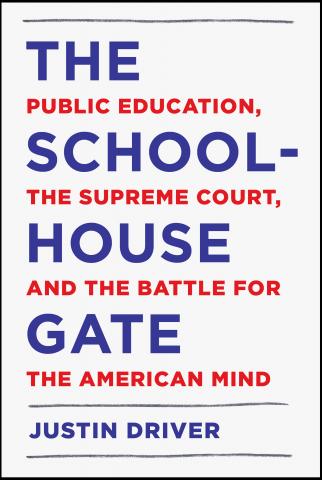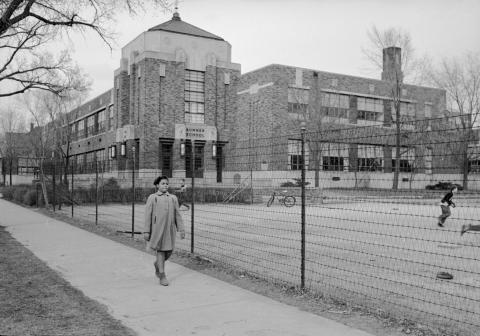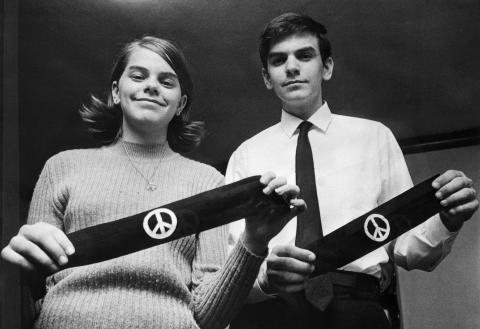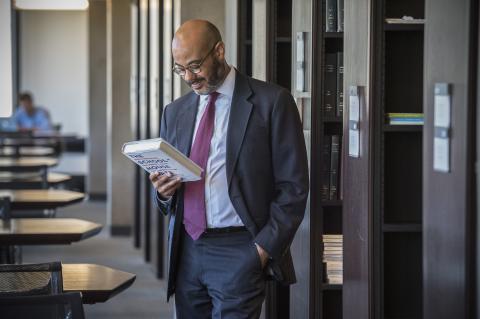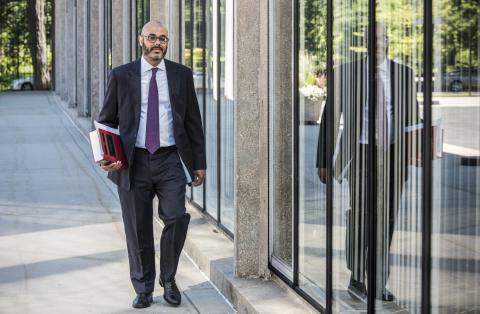The Constitution Goes to School
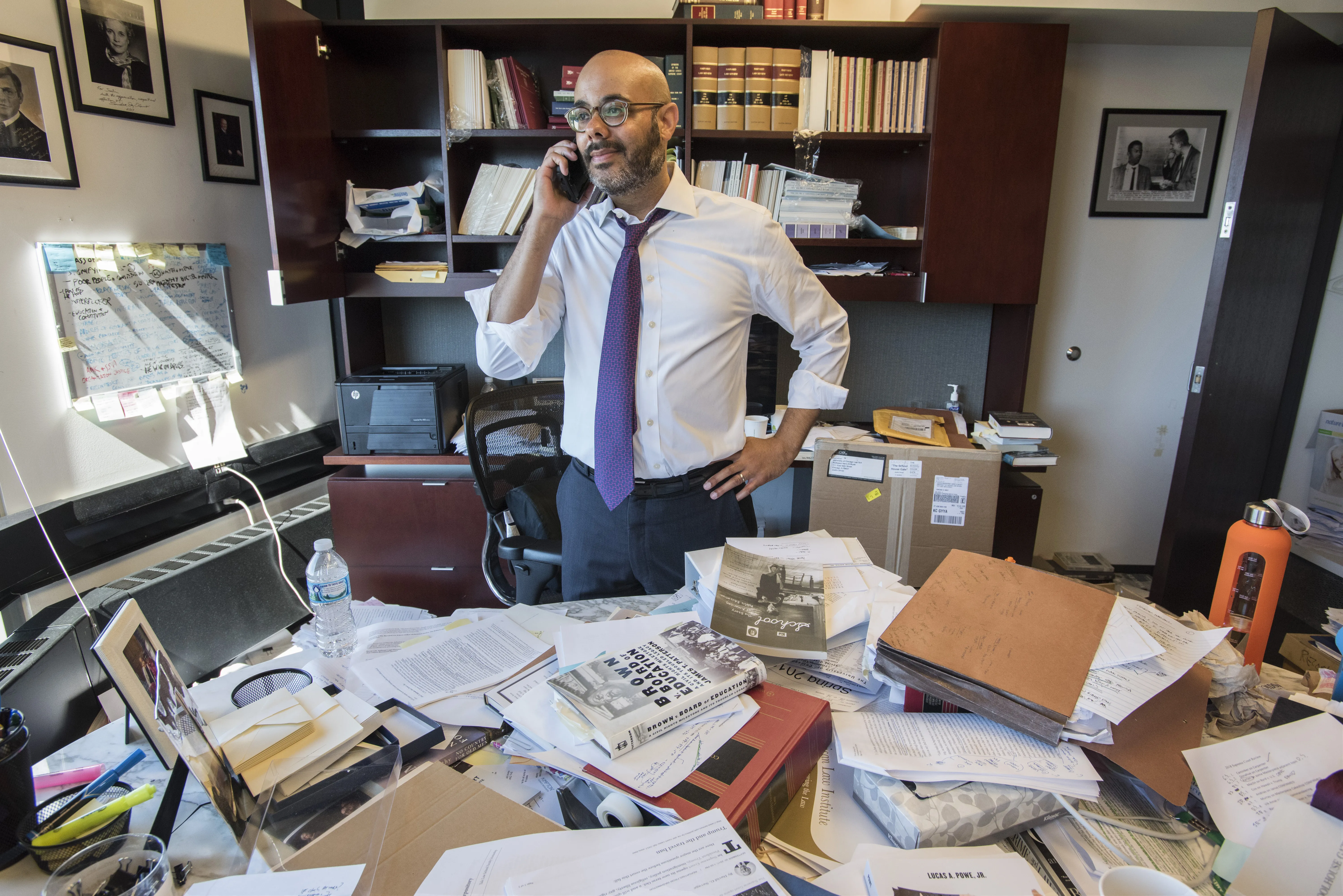
Professor Justin Driver’s new book was either four years or three decades in the making, depending how you count it.
There are the recent years he spent researching and writing The Schoolhouse Gate: Public Education, the Supreme Court, and the Battle for the American Mind (Pantheon Books). And then there is the lifetime of personal experiences and scholarly endeavors that triggered his inquiry, providing myriad vantage points that inspired him, again and again, to consider how the law shapes public schools.
Driver is, at once, the public school student whose dad slept part of a night in his car outside a school so he could be among the first in line to enroll his son in an out-of-district junior high, and he’s the young man who spent a year teaching high school in Durham, North Carolina. He’s the Supreme Court clerk who watched his boss, Justice Stephen Breyer, wrestle with cases that shaped the legacies of two of America’s most momentous education decisions, and he’s the graduate student at Oxford University who examined school-funding disparities. He’s a scholar of constitutional law, one who developed a Law School class called The Constitution Goes to School, and he’s the father to two young children.
“I’ve been inexorably drawn to these concepts over the years,” said Driver, the Harry N. Wyatt Professor of Law. “This book represents the culmination of years of thinking.”
Driver grew up in a predominantly black neighborhood in Southeast Washington, DC, with parents who were determined to give Driver and his older brother the tools they needed to succeed academically. For years Driver commuted to a more affluent school on the opposite side of the city, taking a bus and two subway lines and then walking nearly a mile—a trek that gave him time to think about equality, education, and opportunity. Not everyone, he knew, had parents like his.
Over the years, he also realized this: millions are shaped for better or worse by their early educational experiences—making the public school “the single most significant site of constitutional interpretation within the nation’s history.”
“No other arena of constitutional decision making—not churches, not hotels, not hospitals, not restaurants, not police stations, not military bases, not automobiles, not even homes—comes close to matching the cultural import of the Supreme Court’s jurisprudence governing public schools,” he wrote in The Schoolhouse Gate.
Part of it comes down to sheer size: most Americans are required to attend school, and few have options beyond public education.
“It is the first sustained exposure that most citizens have to a governmental entity,” Driver said. “These early encounters with the government play a foundational role in shaping attitudes that students will have with them for the rest of their days.”
Although Driver includes plenty of legal analysis, The Schoolhouse Gate is, at its core, a story about people. It’s about the children and families whose experiences led them to the center of precedent-setting cases—individuals like John and Mary Beth Tinker, who fought for their right to express a political belief by wearing black armbands to school; or Gavin Grimm, who fought to use the bathroom that matched his gender identity (an issue that still has not been resolved); or Oliver Brown, who fought to send his daughter Linda to the all-white school that was just seven blocks from their house. It is also about—and for—the people who make up one of the book’s most important audiences: the millions of students, parents, and teachers whose lives are affected each day by the laws that govern their schools.
“I was aiming for a stimulating work of constitutional law that is also accessible to the people who confront these questions on the front lines—sophisticated students, parents, teachers, and administrators,” he said. “Many people who work in the educational profession are aware that constitutional principles inform what they do, but they might have only a vague understanding of the actual conflict that led to the rule and even the rule itself.”
Over more than 400 pages, Driver unpacks decades of history, examining broader messages about inequality, cultural anxiety, and the ways in which education law mirrors America’s broader scuffle with civil liberties. In the past century, the Supreme Court has considered public education cases dealing with religion, patriotism, free speech, due process, search and seizure, racial segregation, gender discrimination, unauthorized immigration, corporal punishment, random drug testing, funding disparities, transgender bathroom rights, and more.
“The public school has become a major flashpoint for the larger cultural conflicts that pervade our society,” Driver said.
At points, he questions cherished narratives—wondering, for instance, whether the mission to achieve unanimity in Brown v. Board of Education in 1954 hindered future efforts to address persistent racial isolation in urban school districts, particularly in northern cities like Chicago. He also challenges the idea that the Supreme Court tends to follow the predominant views of the American public, pointing to the 1962 ban on teacher-led prayer in Engel v. Vitale, which drew widespread public rebuke, and even the much-lauded Tinker v. Des Moines Independent Community School District, a landmark 1969 ruling that affirmed students’ right to engage in symbolic antiwar speech. Like Brown, Tinker has inspired decades of adulation: its 7–2 ruling was widely praised in the media, and the case ultimately paved the way for modern student protests like the 2018 anti–gun violence walkouts that took place in schools across the country.
But it was Justice Hugo Black’s vehement dissent that, in retrospect, most likely offered the better barometer of public opinion, Driver said. Although some dismissed Black’s view as an outlier perspective, it seems to have reflected “a deep wellspring of cultural anxiety” that schools would lose control of their students, Driver said, noting that several subsequent cases—including Morse v. Frederick, which allowed the suppression of speech that promoted drug use, and Bethel v. Fraser, which allowed the suppression of sexually suggestive language—limited Tinker’s reach. For some, those cases were a relief and an overdue restoration of schoolhouse order.
Throughout the book, Driver examines the interplay between education law and public sentiment, tracing a meticulous history from one case to the next through public polling data, newspaper editorials and opinion columns, scholarly analysis, and other contemporary reports that offer insight into how each case fit its era.
The pictures he paints are rich and multilayered. They are rife with public misunderstandings about the Supreme Court’s intent—Engel v. Vitale, for instance, didn’t prevent students from praying on their own, and Goss v. Lopez didn’t provide procedural protections more elaborate than simple hearings. He chronicles the complex tangle of fears that has driven public debate over discipline and safety—describing, for instance, how school shootings have stoked support for increasingly invasive searches of students and their property—and he discusses close decisions that, had the timing or other details been slightly different, could have shifted the entire trajectory of education law.
“When you situate a case in the historical context, you can better understand what outcomes were plausible,” Driver said. “I don’t believe that Supreme Court justices operate completely outside of society, but unlike many of my fellow law professors, I believe that there’s a much, much larger plausible range of outcomes on particular decisions rather than assuming, ‘Of course the justices have to decide this way because they were born in this era.’”
Driver takes a normative approach, heralding the bravery of families whose cases fomented change and celebrating many of the rulings that validated students’ rights. The book, in fact, draws its name from Justice Abe Fortas’s famous line in Tinker: “It can hardly be argued that either students or teachers shed their constitutional rights . . . at the schoolhouse gate.”
But Driver also laments what he sees as the Court’s shortcomings, pointing to rulings that have upheld corporal punishment, suspicionless drug testing, searches without probable cause, and the suppression of certain types of speech.
These failures, he argues, have enormous reach.
FINE LINES AND DEEP IMPACT
It was Justice Breyer who hammered home for Driver just how deeply the Court touches American lives when it interprets the constitutional condition of public schools.
By 2006, Driver had already given both education and law more than a decade of serious thought. He’d worked as an undergraduate research assistant for a history professor who was writing a book on the legacy of Brown v. Board of Education, and he’d spent a year teaching high school civics and American history in North Carolina. As a Marshall Scholar at Oxford, he’d studied the history of school-financing disparities with a focus on the 1973 Supreme Court case San Antonio Independent School District v. Rodriguez. He’d earned a law degree and had clerked for Judge Merrick Garland of the US Court of Appeals for the DC Circuit.
But it was during the 2006 term with Breyer that Driver witnessed two pivotal students’ rights decisions: Parents Involved in Community Schools v. Seattle School Dist. No. 1, which invalidated voluntary school integration programs in Seattle and Louisville, and Morse v. Frederick, which affirmed a school’s decision to suppress speech that promoted illegal drug use (in this case, a student sign that read “BONG HiTS 4 JESUS”). Both cases grappled with powerful legacies: The Frederick decision limited Tinker’s scope, one of several rulings that found exceptions to students’ free speech protections. Parents Involved forced the Court to confront one of the lingering questions that emerged in the years after Brown: whether school districts could employ measures designed to counter racially imbalanced schools.
Breyer spent “enormous amounts of time and energy” on both cases—and Driver took note.
“Justice Breyer has stated publicly that he thought the Parents Involved case was the single most important dissent that he’s written in his close to 25 years on the Supreme Court—and it was clear that he felt passionately about that case,” Driver said. “He spoke from the bench for 20 minutes announcing his dissent, which of course signals vehement disagreement.”
Breyer disagreed with Chief Justice John Roberts’s color-blind reading of Brown—the idea that its precedent prohibited any racial classification, including to achieve balanced school assignments—and worried that the Court had taken from schools a critical tool aimed at combating racial isolation. The consequences would be far-reaching, Breyer said, proclaiming from the bench: “It is not often in the law that so few have so quickly changed so much.”
The stakes were clear to Driver: Education law shapes entire communities by influencing how the youngest members learn to share ideas and view authority, whether they interact with diverse peers or have access to life-changing opportunities, and in some cases whether they attend school at all.
Plyler v. Doe established that unauthorized immigrants have the right to attend school—and Wisconsin v. Yoder established that Amish children had the right not to attend school after the eighth grade. Goss v. Lopez provided basic procedural protections for students facing suspension, and—in a case Driver would relish seeing reversed—Ingraham v. Wright permitted schools to inflict corporal punishment.
Brown arguably helped set the stage for the next six decades of race relations in America.
In his discussion of the case, Driver devotes time to one aspect in particular: “I do have some skepticism about whether the unanimity of the opinion deserves to be as widely celebrated as it is,” he said.
Specifically, he wonders if Chief Justice Earl Warren could have written a “more muscular opinion”—perhaps a stronger condemnation of Jim Crow laws and a more emphatic stance against segregation—had he not needed to accommodate Justice Stanley Reed, who had been initially opposed. A stronger Brown, he argues, might have limited efforts to minimize the decision’s impact—and it might have opened greater opportunities for successful racial integration.
The frustration in considering what might have been, of course, is that “might have” was, in some cases, a fairly close call.
Driver can easily imagine, for instance, a different outcome in Rodriguez, the funding disparity case he studied at Oxford. The case centered on the constitutionality of the San Antonio Independent School District’s financing system, which allocated funds according to local property tax revenue—in effect providing better school resources in richer communities. The petitioner claimed that the plan violated the 14th Amendment’s Equal Protection Clause, and the Court disagreed in a 5–4 vote. Had the decision arrived just a few years earlier—at the tail end of the left-leaning Warren Court instead of during Chief Justice Warren Burger’s Court in 1973—the outcome might well have been flipped, Driver said.
Of course, he thinks the same could be true of Plyler v. Doe, the 1982 decision that upheld the rights of unauthorized immigrants to attend school. Driver can imagine today’s Court deciding otherwise.
“I’m struck by the contingency of constitutional interpretation in this area,” Driver said. “It is quite plausible to believe that several momentous cases could have been decided the other way.”
REAL EXPERIENCES, REAL LIVES
Driver can also imagine a different outcome in a far more personal episode, one that sometimes causes him to think about Justice Lewis F. Powell Jr.’s dissent in Goss v. Lopez, the 1975 case that recognized the right to a brief hearing before suspension.
Powell derided the “frustrating formalities” of due process, criticizing the Court’s interference in school procedure and claiming that the vast majority of students viewed suspension as “a welcome holiday” free of lasting consequence.
Driver doesn’t quite see it that way. Nor did he see it that way in the ninth grade, when a youthful transgression—drinking with friends on an overnight field trip—earned him a three-day suspension. The experience was searing. It was the sort in which every detail etches a permanent spot on the brain: the long walk to the principal’s office, the tears, the burning shame.
It was not in any sense a “welcome holiday.”
But it could have been worse: it could have happened a decade later, after the rise of zero-tolerance policies.
“Rather than being suspended for three days, I would have, I believe, been suspended for the rest of the school year,” Driver said. “Had that happened, it’s very difficult to imagine that I’d be sitting here at the University of Chicago.”
Driver worries about some of the trends that have emerged in recent years: the rise of police officers stationed in schools, which has led to excessive arrests, “too many of whom are racial minorities,” Driver said. He worries about rulings that have exempted schools from certain aspects of the Fourth Amendment ban on unreasonable search—most notably by allowing suspicionless drug testing and searches of student belongings, without probable cause, to find evidence of school-rule violations. He is concerned about the erosion of Tinker, which can diminish the quality of discourse that is essential to the educational experience.
“The school itself has often been an important site for exchanging ideas on the topic of the day,” Driver wrote. “The student-led protests supporting gun control legislation in response to the mass shooting at Marjory Stoneman Douglas High School in Parkland, Florida, in February 2018 are but the latest, high-profile examples of this longstanding trend.”
But his area of greatest concern is the continued practice of corporal punishment, which he calls “a relic from a bygone era.”
“The Court made a grave misstep when it said that the Eighth Amendment prohibition on cruel and unusual punishment in effect has no meaning within the school at all and that corporal punishment isn’t punishment because it doesn’t stem from a criminal conviction,” Driver said, referring to the 1977 ruling in Ingraham v. Wright. “The idea that the Eighth Amendment has no purchase within the schoolhouse gate strikes me as quite wrongheaded and deeply in need of revisiting.”
Reforms in these areas are possible regardless of the makeup of the Court, he added, pointing to state courts and legislative bodies as possible avenues for change.
Whatever form it takes, however, change will probably require the courage of individuals, people like the Tinkers or the Browns, who encountered fierce criticism and harrowing legal experiences.
“They were standing up not only to their schools, but they were also standing up to their communities,” Driver said.
It is a point that is easy to forget amid the legal analysis: each of these issues stemmed from the real experiences of real people, he said. It is an idea he hopes his readers more fully understand after reading his book.
“[E]ven if one disagrees with the underlying constitutional claims, it is often difficult not to admire the students and their families for being willing stand up for their understandings of the Constitution,” Driver wrote. “[D]etailing these concrete personal sacrifices underscores that many otherwise ordinary citizens have exhibited extraordinary valor to make enduring contributions to our constitutional order.”
